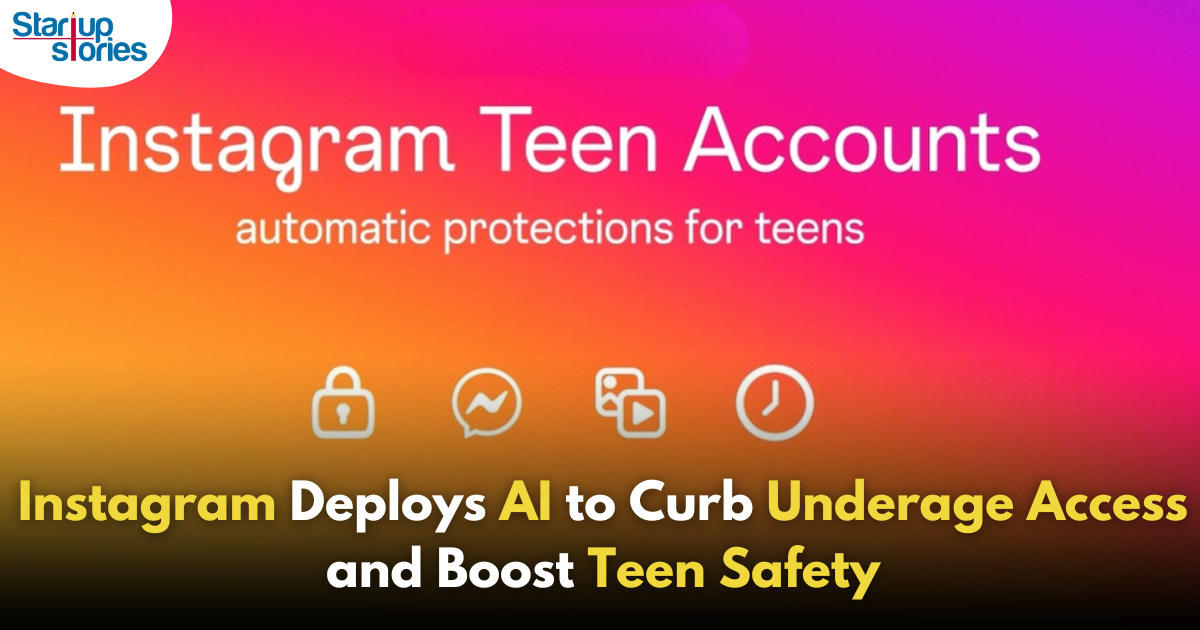Artificial Intelligence
Instagram Uses AI to Tackle Underage Access and Enhance Teen Safety!

Meta, the parent company of Instagram, is introducing an AI-powered tool called the “adult classifier” to prevent minors from lying about their age on the platform. This new tool is part of Meta’s broader initiative to ensure a safer environment for young users, particularly as social media faces scrutiny for its impact on teenage mental health.
Functionality of the Adult Classifier
The “adult classifier” uses artificial intelligence to analyze a variety of online behaviors and profile details to determine a user’s likely age. This includes factors like follower demographics, interactions, and even birthday-related comments from friends. If the AI suspects that a user is under 18, the account is automatically set to a “teen account,” which comes with restricted privacy settings, message limitations, and filtered content.
Current Age Reporting Process
Currently, Instagram users self-report their age during sign-up, but underage users often provide false information to bypass restrictions. The new system, set to launch early next year, will begin flagging accounts where the reported age seems inaccurate. All under-18 users will be placed in teen accounts; however, 16- and 17-year-olds will have some flexibility to adjust settings, while younger teens will require parental permission.
Context and Background
This update comes as Meta faces legal challenges and criticism from state attorneys general and parents, who argue that the platform can negatively impact young people’s mental health. The scrutiny intensified after whistleblower Frances Haugen released internal reports highlighting potential harm to teenage girls.
Legal and Social Pressures
Meta is already facing lawsuits from multiple states alleging that it knowingly designed features that are addictive and harmful to children. These legal challenges underscore the urgency for Meta to implement effective measures for protecting its younger users.
Implementation of Age Verification Measures
The AI system aims to limit the number of underage users who falsely represent their age. However, Meta acknowledges that it may not catch every case. Users attempting to alter age settings will need to verify their identity through ID or a video selfie using a third-party age-verification service.
Collaboration with Age Verification Services
Meta has partnered with Yoti, a tech firm specializing in age verification, allowing users to confirm their age through video selfies. Yoti’s machine learning algorithms estimate a person’s age based on facial features, ensuring that the process remains secure and efficient.
Future Enhancements and Features
In addition to the adult classifier, Meta plans to flag teens who attempt to create a new account using an email address that’s already associated with an existing account but with a different birthday. The company can also utilize device IDs for better identification of users creating new profiles.
Expert Opinions on Age Verification
Some experts suggest that app stores like Google Play and Apple could assist in age verification; however, these companies express concerns about user privacy. The balance between effective age verification and protecting user data remains a critical issue as social media platforms strive to comply with regulations while ensuring user safety.
Conclusion
Meta’s introduction of the adult classifier represents a significant step toward enhancing safety for young users on Instagram. By implementing AI-driven measures to verify ages more accurately, Meta aims to create a more secure online environment for teenagers.
As this feature rolls out in early 2025, it will be essential for Meta to monitor its effectiveness and adapt as necessary based on user feedback and legal requirements. The ongoing commitment to improving safety features reflects broader societal concerns regarding the impact of social media on youth mental health and well-being. With these advancements, Meta hopes not only to comply with regulatory pressures but also to foster a more responsible digital landscape for its younger audience.
Artificial Intelligence
Adopt AI Secures $6 Million to Power No-Code AI Agents for Business Automation

Adopt AI, a San Jose and Bengaluru-based agentic AI startup, has raised $6 million in seed funding led by Elevation Capital, with participation from Foster Ventures, Powerhouse Ventures, Darkmode Ventures, and angel investors. The funding will be used to expand the company’s engineering and product teams and to scale enterprise deployments of its automation platform.
Founded by Deepak Anchala, Rahul Bhattacharya, and Anirudh Badam, Adopt AI offers a platform that lets businesses automate workflows and execute complex actions using natural language commands, without needing to rebuild existing systems. Its core products include a no-code Agent Builder, which allows companies to quickly create and deploy AI-driven conversational interfaces, and Agentic Experience, which replaces traditional user interfaces with text-based commands.
The startup’s technology is aimed at SaaS and B2C companies in sectors like banking and healthcare, helping them rapidly integrate intelligent agent capabilities into their applications. Adopt AI’s team includes engineers from Microsoft and Google, with Chief AI Officer Anirudh Badam bringing over a decade of AI experience from Microsoft.
The company has also launched an Early Access Program to let businesses pilot its automation solution and collaborate on new use cases.
Artificial Intelligence
Social Media Platforms Push for AI Labeling to Counter Deepfake Risks

Social media platforms are intensifying efforts to combat the misuse of deepfake technology by advocating for mandatory AI labeling and clearer definitions of synthetic content. Deepfakes, created using advanced artificial intelligence, pose significant threats by enabling the spread of misinformation, particularly in areas like elections, politics, and personal privacy.
Meta’s New Approach
Meta has announced expanded policies to label AI-generated content across Facebook and Instagram. Starting May 2025, “Made with AI” labels will be applied to synthetic media, with additional warnings for high-risk content that could deceive the public. Meta also requires political advertisers to disclose the use of AI in ads related to elections or social issues, aiming to address concerns ahead of key elections in India, the U.S., and Europe.
Industry-Wide Efforts
Other platforms like TikTok and Google have introduced similar rules, requiring deepfake content to be labeled clearly. TikTok has banned deepfakes involving private figures and minors, while the EU has urged platforms to label AI-generated media under its Digital Services Act guidelines.
Challenges Ahead
Despite these measures, detecting all AI-generated content remains difficult due to technological limitations. Experts warn that labeling alone may not fully prevent misinformation campaigns, especially as generative AI tools become more accessible.
Election Implications
With major elections scheduled in 2025, experts fear deepfakes could exacerbate misinformation campaigns, influencing voter perceptions. Social media platforms are under pressure to refine their policies and technologies to ensure transparency while safeguarding free speech.
Artificial Intelligence
Transforming India’s AI Landscape: OpenAI and Meta’s Collaborative Talks with Reliance Industries

OpenAI and Meta Platforms are reportedly in discussions with India’s Reliance Industries to explore potential partnerships aimed at enhancing their artificial intelligence (AI) offerings in the country. This development underscores India’s growing significance in the global AI landscape.
Key Aspects of the Discussions
- Partnership with Reliance Jio: One of the main focuses is a potential collaboration between Reliance Jio and OpenAI to facilitate the distribution of ChatGPT in India. This could enable wider access to advanced AI tools for businesses and consumers, leveraging Reliance’s extensive telecommunications network.
- Subscription Price Reduction: OpenAI is considering reducing the subscription cost for ChatGPT from $20 to a more affordable price, potentially just a few dollars. While it is unclear if this has been discussed with Reliance, such a move could significantly broaden access to AI services for various user demographics, including enterprises and students.
- Infrastructure Development: Reliance has expressed interest in hosting OpenAI’s models locally, ensuring that customer data remains within India. This aligns with data sovereignty regulations and addresses growing concerns about data privacy. A planned three-gigawatt data center in Jamnagar, Gujarat, is expected to serve as a major hub for these AI operations.
Market Implications
These potential partnerships reflect a broader trend among international tech firms aiming to democratize access to AI technologies in India. If successful, they could reshape India’s AI ecosystem and accelerate adoption across various sectors. As negotiations continue, stakeholders are closely monitoring how these alliances may impact India’s technological landscape and its position as a leader in AI innovation.














poweraigo
January 22, 2025 at 1:28 am
В текущем мире портативных технологий power bank стал необходимым аксессуаром для обладателей телефонов и других переносных устройств. Это компактное зарядное устройство выступает как автономный аккумулятор с встроенным аккумулятором, позволяющий заряжать различные устройства где угодно. На рынке представлено множество моделей, включая современные решения, такие как [url=https://powerbanki.top/ ]Можно ли оставить зарядку в розетке на powerbanki.top [/url], которые позволяют заряжать устройства даже в полевых условиях. Основными характеристиками при выборе выступают емкость аккумулятора, количество портов, скорость зарядки и поддержка различных протоколов быстрой зарядки.
Пристальное внимание стоит уделить выбору повербанка для iPhone, учитывая уникальность зарядки устройств Apple. Актуальные беспроводные пауэрбанки поддерживают технологию MagSafe, предоставляя максимально комфортное использование с iPhone 12 и более современными моделями. При выборе следует обратить внимание на сертификацию MFi (Made for iPhone), которая гарантирует безопасность использования аксессуара с устройствами Apple. Производительные модели с емкостью 50000 mAh в состоянии обеспечить до 10-12 полных зарядов iPhone, а также подходят для зарядки MacBook и других ноутбуков благодаря поддержке USB Power Delivery.
Источник: [url=https://powerbanki.top/ ]https://powerbanki.top/ [/url]
по вопросам що таке power bank – обращайтесь в Telegram knr95
Kod polecajacy Binance
March 7, 2025 at 6:15 pm
Thank you for your sharing. I am worried that I lack creative ideas. It is your article that makes me full of hope. Thank you. But, I have a question, can you help me?
binance referral code
May 9, 2025 at 3:41 pm
Can you be more specific about the content of your article? After reading it, I still have some doubts. Hope you can help me.
yf8v2
June 8, 2025 at 5:24 am
order cheap clomiphene no prescription how can i get cheap clomiphene without prescription clomid for sale in mexico buy cheap clomiphene can i order clomiphene for sale clomid generico where to get cheap clomid
binance
September 15, 2025 at 12:23 pm
Thanks for sharing. I read many of your blog posts, cool, your blog is very good. binance registration
Регистрация на www.binance.com
October 27, 2025 at 8:15 pm
Thank you for your sharing. I am worried that I lack creative ideas. It is your article that makes me full of hope. Thank you. But, I have a question, can you help me?
J88
November 5, 2025 at 11:20 pm
Đến với J88, bạn sẽ được trải nghiệm dịch vụ cá cược chuyên nghiệp cùng hàng ngàn sự kiện khuyến mãi độc quyền.
MM88
November 8, 2025 at 6:50 pm
Với giao diện mượt mà và ưu đãi hấp dẫn, MM88 là lựa chọn lý tưởng cho các tín đồ giải trí trực tuyến.
谷歌外推
November 11, 2025 at 6:40 am
采用高效谷歌外推策略,快速提升网站在搜索引擎中的可见性与权重。谷歌外推
站群程序
November 12, 2025 at 6:12 pm
搭载智能站群程序,自动化搭建与管理,为SEO项目提供核心驱动力。站群程序
open binance account
November 15, 2025 at 6:20 pm
Can you be more specific about the content of your article? After reading it, I still have some doubts. Hope you can help me.
MM88
November 16, 2025 at 5:16 am
Khám phá thế giới giải trí trực tuyến đỉnh cao tại MM88, nơi mang đến những trải nghiệm cá cược thể thao và casino sống động.
GO88
November 23, 2025 at 9:58 pm
Tham gia cộng đồng game thủ tại Go88 để trải nghiệm các trò chơi bài, poker phổ biến nhất hiện nay.
Kuwin
November 24, 2025 at 7:52 pm
kuwin sở hữu kho game đa dạng từ slot đến trò chơi bài đổi thưởng, mang đến cho bạn những giây phút giải trí tuyệt vời.
iwin
November 30, 2025 at 3:22 pm
iwin – nền tảng game bài đổi thưởng uy tín, nơi bạn có thể thử vận may và tận hưởng nhiều tựa game hấp
Skapa personligt konto
December 1, 2025 at 2:52 pm
Thanks for sharing. I read many of your blog posts, cool, your blog is very good.